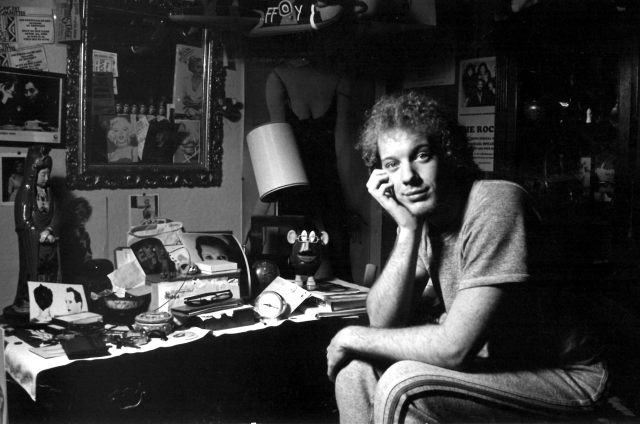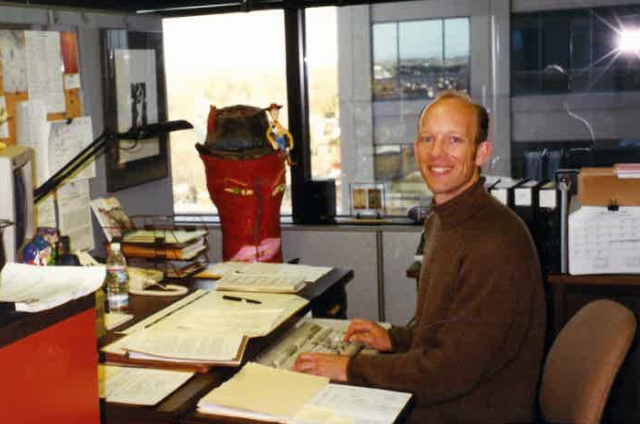One of the most often-heard remarks around the California Arts Council office has, for years, been: “That’s a Scott question.”
What should we do if … Have we ever … How do we … Which artist is … When is the deadline for … Where is … How much is … Do we have a … Those are all “Scott questions,” and they pop up every day.
Scott William Heckes has served the California Arts Council in one capacity or another for over thirty years. He presently serves as our Deputy Director, wearing several hats including Chief of Administration and Chief of Programs. You know the old adage that “nobody is indispensible?” It’s not true. Scott Heckes is indispensible. And we’re about to lose him.
Cue the violins.
AN UNLIKELY ARTS HERO
A career in the arts was not on Scott’s radar as he grew up in Sacramento. He entered Sacramento State University as a criminal justice major—having seen one too many episodes of “Starsky and Hutch.” It became clear after just a few courses, however, that criminal justice was not what he’d envisioned while watching all those great 70s cop shows. Scott, no longer certain of his direction, changed his major to business. He figured that would be applicable to just about anything.
Meanwhile, his sister was majoring in art history and some of his friends were studying visual arts. They had an art history class scheduled during a time when Scott had a break between classes, so he tagged along. Scott ended up auditing the class. He loved it so much that he actually participated in class, even though he was not officially enrolled.

A friend who was interested in public relations invited Scott to join the Associated Students’ Concert Committee—an arm of student government responsible for bringing artists to perform at Sacramento State. The Concert Committee sounded like fun, and it was. The first event Scott helped to organize brought mimes Shields and Yarnell to perform in the men’s gymnasium. As Scott and his friends plunged into the work, the importance, prestige and power of the Concert Committee grew. They booked Peter Frampton, Pablo Cruise, The Ramones, Pat Metheny … exciting stuff. Scott began to dream of becoming the next Bill Graham.

It wasn’t a far-fetched idea. Scott became Production Chairman and excelled at handling all the details, from security arrangements to stage setup. The Concert Committee grew so vital to the campus that classes would be canceled to enable the acts they booked to have private access to the gym’s locker rooms. Scott received valuable experience in juggling details, making things happen, remaining calm under pressure, soothing prima donnas, learning quickly on the job, and appreciating great artistry—all of which came in handy later, as he morphed into the central cog in the CAC machine.
During his last semester at Sacramento State, Scott interned at the Sacramento Metropolitan Arts Commission. At this point, he had never heard of the California Arts Council or even the National Endowment for the Arts—but the head of Sacramento State’s art department, Phil Hitchcock (who had recommended Scott for the SMAC internship), clued him in. In December of 1983, Scott received bachelor’s degrees in both Business and Communications. And in March of 1984, he came to the California Arts Council. No positions were available, and paid internships were only given to students who were still enrolled, not to graduates. So Scott volunteered.
VIRTUE REWARDED … EVENTUALLY
For the next two years, Scott worked at the California Arts Council part time without pay. He supported himself by working nights at Weinstock’s Department Store and part time for the IDEA Gallery as Operations Manager. Meanwhile, the CAC repaid his energy, his dedication, and his intelligence by training him, and treating him, as if he were staff. Scott coordinated a site visit program with Ray Tatar, who was then our Theater Specialist. But when it came time to give oversight of this program to an intern, the job was handed to one of the official, paid interns – a student.
At about the same time, Dance Specialist Anne Smith was leaving the CAC to start a consulting business in San Francisco. At Anne’s invitation, Scott moved to San Francisco to work as an arts consultant, leaving us bereft. We totally deserved it.
Scott began working half time at Anne Smith’s consulting business and half time as operations manager for Rosa Montoya’s Bailes Flamenco. But while he was in San Francisco, the CAC “posted an exam”—governmentspeak for “announced a job opening.” We will be forever grateful that Scott took the exam. He jumped through the hoops with his customary flair, and we were finally able to offer him a position.
Scott began working full-time for the California Arts Council in November of 1986 as an Assistant Arts Grants Administrator in the State/Local Partnership Program. It’s difficult, in these lean years, to picture this, but we have it on excellent authority (Scott’s) that in those days the SLP program employed three full-time arts specialists and a secretary. And while working on the SLP program, Scott visited every single California county (yes, Modoc, we’re looking at you).
THE LONG AND WINDING ROAD
Over the next three decades or so, Scott brought his unique skill set to every facet of this agency. He worked in Organizational Support, eventually becoming the Manager of Organizational Support and overseeing nine discipline categories. As Organizational Support Manager, Scott attended every panel—and in those days, there were many. He says, “You really got a sense of what was happening artistically in the state.”

But he did more. Scott served as a Visual Arts Specialist. He worked on the Art in Public Buildings program, tying up loose ends after the program was discontinued. He briefly managed the Touring and Presenting program. He was promoted to Assistant Chief of Programs (a title he shared with the legendary Josie Talamantez, who oversaw a different set of programs). And during the budget trauma of 2002-2004, when the California Arts Council lost 94% of its funding and most of its staff, Scott was asked to step in and serve as Chief of Administration.
This was a time of high anxiety. Layoffs are always traumatic, particularly at this scale. But Scott reports that the skills and flexibility the staff acquired while working here served them well. All the CAC staffers who were targeted for layoff found jobs in other state agencies during the six-month warning period, leaving the CAC with nobody to let go at the end of the process. And as time went on and the agency learned how to make do with less, some of them came back. “Nobody quits the CAC,” says Scott—and he ought to know, since he has been a large part of what makes this agency such a stellar place to work.

Scott’s role at this agency has been unique. We have benefited from the talents of dedicated programs staff with similar longevity, and accounting personnel who have been with us for years, but only Scott has bridged those two sides of the agency by working as a programs staffer—and on so many programs!—and also working in administration, rising to the management level in both areas.
When Scott stepped into the Chief of Administration role, chaos reigned. Our budget had been slashed, the person who had filled the job before him was gone, and there was no one to train him. Scott found himself in a brand new position of intense responsibility with no mentor, no reference materials, and no clear path forward. The word he uses to describe the situation is “harrowing.” Scott vowed that whoever his successor was, he would not leave that person similarly adrift. He has kept a careful, clearly-organized paper trail “from Day One – for better or worse,” he says, ruefully surveying his neatly-labeled, but thoroughly intimidating, stacks of deadlines and instructions.

For all good things must come to an end, and Scott Heckes is retiring. His last day in the office will be July 30th. Scott’s present position is Deputy Director, and as the agency has evolved, more and more of its reins ended up in his capable hands. He now serves (unofficially) as both Chief of Administration and Chief of Programs in addition to his responsibilities as Deputy Director. Only Scott could wear all three hats at once.
KISS TODAY GOODBYE
What makes Scott unique? His dual perspective as an arts programs person and an administrative wiz. His ability to bring order out of chaos. And his pure, disinterested love of the arts.
By “disinterested,” we mean that Scott’s love for the arts—particularly visual arts—is completely free of ego. He claims no talent of his own. He does not paint. He does not sing. He does not sculpt, or act, or dance, or play an instrument. And yet his eyes light up when a new gallery catalog comes through the door. He has collected so much art over the years that wall space is a major consideration when house hunting. His admiration for our panelists is deep and sincere. We have seen him absolutely star-struck over the chance to meet and work with artists we’ve barely heard of. Scott knows them all. Loves them all. And inspires everyone around him with his contagious enthusiasm, arcane knowledge, and the joy of appreciation.
Of course we asked him what his best memory was. And of course it was hard for him to pick just one. But one experience was a stand-out.
During his intern days, Anne Smith gave him tickets to the Joffrey Ballet at the War Memorial Opera House in San Francisco. Scott had never been to the ballet. He had also never been to the War Memorial. But Anne knew Scott’s love of early twentieth century arts and this particular ballet was the Joffrey’s revival of Leonide Massine’s Parade, featuring elaborate sets and costumes designed by Picasso. “Trust me,” said Anne. “You’ll love it.”
Scott arrived at the War Memorial not knowing quite what to expect. To his surprise, he was greeted at will-call and personally escorted to the Director’s Box. Scott was half afraid he was going to be “found out” somehow…after all, he was just an intern! But apparently there was no mistake. He and his friend Kelly took their seats amid the grandeur of the War Memorial theater and drank it all in. When the orchestra began playing, right in front of them, and the huge velvet curtain rose to reveal a breathtaking scrim designed by Picasso, Scott felt overwhelmed. The music, the visual elements, and the movement all combined in an unforgettable, transformative experience that has stayed with him ever since.

Scott says, “This job has been a true education for me.” All we can say is, we’re glad the California Arts Council was able to provide it. We’re stamping an “A+” on your forehead and sending you off to new adventures and, we hope, many more unforgettable, transformative encounters with the arts.
Bon voyage, dear friend.

See more comments at: http://cac.ca.gov/blog/blogdetail.php?id=211#sthash.4JNhvC3O.dpuf
